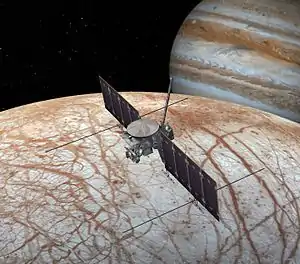Interior Characterization of Europa using Magnetometry
The Interior Characterization of Europa using Magnetometry (ICEMAG) is a multi-frequency magnetometer that was proposed to be flown on board the Europa Clipper mission to Jupiter's moon Europa, but its inclusion was cancelled in March 2019.[1] Magnetic induction is a powerful tool for probing the subsurface and determine Europa's ocean depth, salinity, and ice shell thickness, as well as detecting erupting plume activity.
| Operator | NASA |
|---|---|
| Manufacturer | Jet Propulsion Laboratory |
| Instrument type | Magnetometer |
| Function | internal planetary characterization and exosphere activity |
| Mission duration | Cruise: 3-6 years Science phase: ≥ 3 years |
| Host spacecraft | |
| Spacecraft | Europa Clipper |
| Operator | NASA |
| Launch date | ≈ 2025 (instrument cancelled)[1] |
| Rocket | SLS |
| Launch site | Kennedy Space Center |
The Principal Investigator is Carol Raymond, at NASA's Jet Propulsion Laboratory.[2]
On March 5, 2019, NASA's Associate Administrator for the Science Mission Directorate, Thomas Zurbuchen, announced that ICEMAG would no longer be part of the Europa Clipper mission, primarily citing recurring cost increases (over three times the original cost put forward in the proposal).[3] A less complex magnetometer will be included on the mission.[3]
Overview
Magnetic induction is a powerful tool for probing the subsurface. ICEMAG would have observed the magnetic field near Europa with greatly enhanced sensitivity compared to a similar instrument carried by NASA's Galileo spacecraft, which orbited Jupiter from 1995 to 2003. The magnetic field induced in Europa over many frequencies would reveal the ocean depth and ice shell thickness, especially when combined with the REASON ice penetrating radar data and the PIMS instrument. Knowledge of the ocean properties would help understand Europa's evolution and allow evaluation of processes that have cycled material between the depths and the surface, and would help assess the ocean's potential habitability.[4][5] ICEMAG would have helped in understanding not only what Europa is made of, but also the processes that link the ocean to the surface, and how the system works.[4]
ICEMAG was to utilize fluxgate magnetic field sensors[6] and helium sensors in an integrated magnetic measurement system.[7] Electromagnetic waves between 10−2 to 1 hertz could reveal localized mass flow of ions arising from plumes and the atmosphere; that is, localized transient currents indicate plume activity.[2] In general, ICEMAG data would have combined synergistically with other data sets to improve knowledge of interior properties and exosphere activity.
The instrument was put under review in the summer of 2018 due to increasing costs. By March 6, 2019, the instrument was cancelled in favor of finding a more affordable, less complex replacement. The cause of the cost increases was traced to the helium sensors used to detect the direction and strength of a magnetic field.[1]
Objectives
The objectives of the ICEMAG investigation were to be:[2]
- Constrain Europa's thermal evolution and current interior state
- Identify the source of the Europan atmosphere and processes by which it is lost
- Understand coupling between Europa and Jupiter's ionospheres and coupling of plumes to the flowing plasma
- Determine the location, thickness and salinity of the Europan ocean
- Locate of any active vents, plumes, and ionized plasma trails, the strength of plumes, and loss rates from the atmosphere
- Determine the strength of electric currents and plasma coupling Jupiter to Europa
References
- Foust, Jeff (March 6, 2019). "NASA to replace Europa Clipper instrument". SpaceNews. Retrieved March 6, 2019.
- Raymond, Carol; et al. (August 24, 2015). "ICEMAG - Interior Characterization of Europa Using Magnetometry" (pdf). Outer Planets Assessment Group.
- Zurbuchen, Thomas H. (March 5, 2019). "ICEMAG Update on Europa Clipper". SpaceRef. NASA. Retrieved March 6, 2019.
- Dyches, Preston (May 27, 2015). "Europa Mission to Probe Magnetic Field and Chemistry". NASA News. Retrieved March 7, 2019.
- Tribou, Richard (June 19, 2015). "NASA going to Jupiter moon Europa to hunt for water, keys to life". Orlando Sentinel. Orlando, FL. Retrieved November 12, 2017.
- "Fluxgate Magnetometer | ELFIN". Electron Losses and Fields Investigation. UCLA. May 6, 2016. Archived from the original on June 16, 2018. Retrieved March 7, 2019.
- Interior Characterization of Europa using Magnetometry (ICEMAG): Probing the Europan Ocean and Exosphere. Raymond, C. A.; Jia, X.; Joy, S. P.; Khurana, K. K.; Murphy, N.; Russell, C. T.; Strangeway, R. J.; Weiss, B. P. American Geophysical Union, Fall Meeting 2015, abstract #P13E-08.

